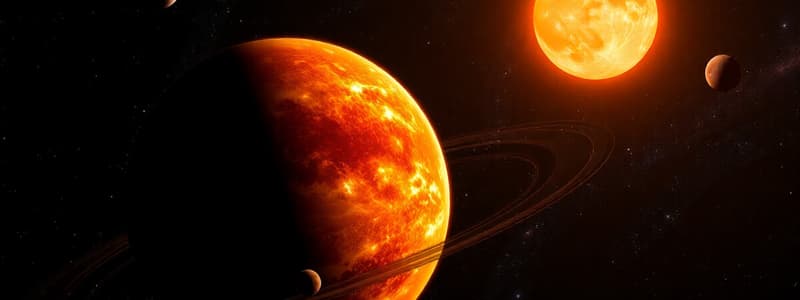Podcast
Questions and Answers
What is the primary source of heat and light for all the planets in the Solar System?
What is the primary source of heat and light for all the planets in the Solar System?
- The Sun (correct)
- Jupiter
- The Moon
- Mars
Which of the following elements constitutes the majority of the Sun's composition?
Which of the following elements constitutes the majority of the Sun's composition?
- Carbon
- Oxygen
- Helium
- Hydrogen (correct)
What is the mean distance from Earth to the Sun?
What is the mean distance from Earth to the Sun?
- 147 Million Km
- 145 Million Km
- 152 Million Km
- 149 Million Km (correct)
How many planets in the Solar System revolve around the Sun?
How many planets in the Solar System revolve around the Sun?
What phenomenon occurs in the Sun's core that generates its energy?
What phenomenon occurs in the Sun's core that generates its energy?
Which of the following statements about the Sun is true?
Which of the following statements about the Sun is true?
What trait is associated with comets when they are close to the Sun?
What trait is associated with comets when they are close to the Sun?
Pluto was reclassified as a dwarf planet primarily because of its:
Pluto was reclassified as a dwarf planet primarily because of its:
Which planet has the highest number of known satellites?
Which planet has the highest number of known satellites?
What is the estimated age of the Sun?
What is the estimated age of the Sun?
Flashcards
Solar System
Solar System
The Sun, Earth, Moon, and other planets orbiting around the Sun.
Sun
Sun
A star that shines with its own light. Our Solar System's star is the Sun.
Moon
Moon
The natural satellite of Earth.
Planets
Planets
Signup and view all the flashcards
Satellites
Satellites
Signup and view all the flashcards
Nuclear Fusion
Nuclear Fusion
Signup and view all the flashcards
Asteroids
Asteroids
Signup and view all the flashcards
Comets
Comets
Signup and view all the flashcards
Revolution
Revolution
Signup and view all the flashcards
Halley's Comet
Halley's Comet
Signup and view all the flashcards
Study Notes
Solar System Overview
- The Sun, Earth, Moon and other celestial bodies form the Solar System
- The Sun is a star providing light to the planets
- Earth is a planet orbiting the Sun
- Planets such as Mars, Mercury, Jupiter, Saturn, Uranus, and Venus also orbit the Sun
- The Moon is Earth's satellite, revolving around Earth
Sun Facts
- Mean distance from Earth: 149 million km
- Maximum distance from Earth: 152 million km
- Minimum distance from Earth: 147 million km
- Diameter: 1,392,000 km (110 times Earth's diameter)
- Mass: 1.989 x 10^30 kg (332,000 times Earth's mass)
- Volume: 1.412 x 10^18 cubic meters(1,300,000 times Earth's volume)
- Composed of 71% Hydrogen and 29% Helium
- Power source: Nuclear fusion of Hydrogen atoms
- Age: More than 4.6 billion years old
Pluto
- Discovered by Clyde Tombaugh in 1930
- Density is equal to water
- Completes one revolution around the Sun in 248.6 years
- Orbital speed: 4.7 km/s
- Has one moon called Charon (1,200 km in diameter)
- Removed from the planetary category in 2006
Asteroids
- Small objects (rocks, debris) orbiting the Sun
- Mostly found in the Asteroid Belt between Mars and Jupiter orbits
- Too small to be considered planets
- Examples: Ceres, Vesta, Psyche
Comets
- Members of the solar system orbiting the Sun in highly elliptical orbits
- Often called "tailed stars" due to bright tails
- Composed of rocky and metallic materials surrounded by frozen gases
- Orbits are long periods
- Examples: Halley's Comet, Schwassmann-Wachmann comet and Otrema
Studying That Suits You
Use AI to generate personalized quizzes and flashcards to suit your learning preferences.




